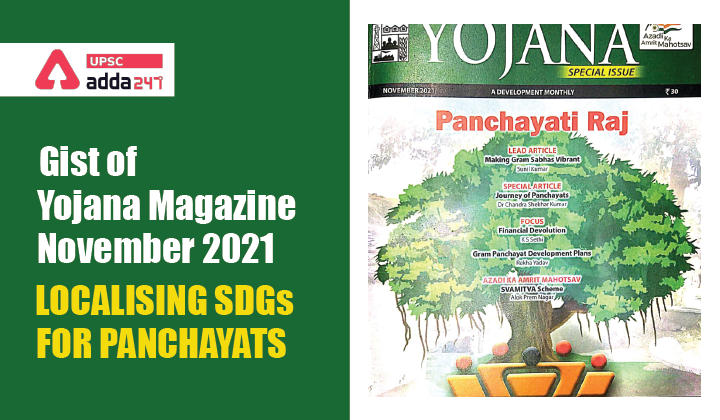Table of Contents
Context
Kerala Institute of Local Government(KILA) has developed a training toolkit for SDGs for Local Self Governments (LSGs).
Background
- The Sustainable Development Goals were agreed upon in September 2015 to energise the world and to show direction for its priorities and actions for the next 15 years- to radically reduce poverty and inequality.
- These ambitious goals aim to end poverty, tackle inequality once and for all, and find lasting solutions to the environmental challenges faced by the world.
- While these goals are global and universally applicable, countries are expected to prioritise and localise SDG targets guided by the ambition and spirit of the agenda but taking into account national and local circumstances.
- This process of “localising the SDGs” requires tools and policy guidance for States, provinces, and panchayats.
- Like, Data-driven decision-making, evidence-based policies, and mutual accountability for development programmes and investments by the government at various levels and other stakeholders.
What is the roadmap for localizing the SDGs?
This roadmap for localizing the SDGs has been drawn up by the Global Taskforce of Local and Regional Governments, UNDP and UN-Habitat to support cities and regions to deliver the 2030 Agenda.
Who is the roadmap for?
- This roadmap aims to support local and regional governments and their associations to implement and monitor the SDGs and to influence national policy-making with a view to creating an enabling environment for action at the local and regional levels.
- The roadmap will also be a useful resource for national policymakers, international organizations, civil society organizations, academia and anyone involved in the implementation and monitoring of the SDGs.
What does “localizing the SDGs” mean?
- The 17 SDGs and 169 targets of the 2030 Agenda must be achieved at global, national and sub-national levels.
- Localization relates both to how the SDGs can provide a framework for local development policy and to how local and regional governments can support the achievement of the SDGs through action from the bottom up and to how the SDGs can provide a framework for local development policy.
Why does localizing matter?
- While the SDGs are global, their achievement will depend on our ability to make them a reality in our cities and regions.
- All of the SDGs have targets directly related to the responsibilities of local and regional governments, particularly to their role in delivering basic services. That’s why local and regional governments must be at the heart of the 2030 Agenda.
What is Data Revolution by Involving Panchayats?
- Data collection and analysis has been a highly specialised field that has excluded most citizens and government officials – some of whom are only able to consume reports at best.
- It is in this context that there is a need for decentralising the data revolution where the panchayats manage data for development
- Most importantly, it ensures that everyone gains a voice on development matters.
- Anyone can examine the panchayat’s data as well as generate citizen data that can be used to improve advocacy of their issues based on their realities.
What is Required for Localising the SDGs?
- While SDGs are global and universally applicable, countries are expected to prioritise and localise SDG targets guided by the ambition and spirit of the agenda but taking into account national and local circumstances.
- This process of “localising the SDGs” requires tools and policy guidance for States, provinces, and panchayats.
- Training Toolkit to address the challenges of achieving SDGs and to ensure a more coherent and convergence between SDGs, State policies, State Five Year Plan, and the Local Self Government Development Plans.
Steps to a Successful LSG Level Data Revolution
- Prepare the Ground
- Organise the Community
- Build Capacity
- Collect Data
- Receive Feedback on the Data Collection Process
- Analyse with People
- Build Linkages for Development
Dashboard for Panchayats
It works as a monitoring mechanism for localising SDGs, decision-makers, policymakers, and service providers for accurate and timely information and data in order to improve the quality of their services.
Planning and Monitoring SDGs
The Monitoring and Evaluation (M&E) platform is developed to help track, monitor, and report on the SDGs and Panchayat Development Plans, and other frameworks. It is a user-friendly and web-based digital platform
Utilities of the Dashboards for driving SDGs
- It will raise awareness on SDG on many levels – within government, media, researchers, and civil society organisations.
- The dashboard will also push SDG localisation in some States/ UTs to the next level where district-level monitoring was initiated, thereby promoting healthy competition among the districts.
- One can view their National SDG performance by goal, target, and indicator:
- Identify data gaps, compare and analyse SDG indicators relevant to LSGs,
- Support the assessment of SDG data availability and gaps, design and develop regional, national,
- sub-national, and Panchayat SDG data monitoring dashboards and reports,
- Where the GP stands vis-a-vis National and State average,
- Plan for actions through GPDP,
- Add new indicators if required for each LSG by themselves,
- Set local targets for each by themselves,
- The annual update can be helpful in monitoring,
- All these can be done by people at the Panchayat level,
- The assessment can be projected in Gram Sabhas,
- Dashboards can aid the Planning and Monitoring of SDGs.



 TSPSC Group 1 Question Paper 2024, Downl...
TSPSC Group 1 Question Paper 2024, Downl...
 TSPSC Group 1 Answer key 2024 Out, Downl...
TSPSC Group 1 Answer key 2024 Out, Downl...
 UPSC Prelims 2024 Question Paper, Downlo...
UPSC Prelims 2024 Question Paper, Downlo...
